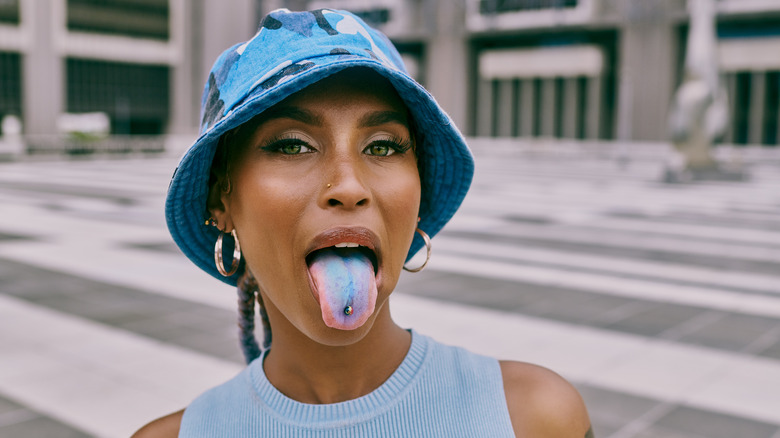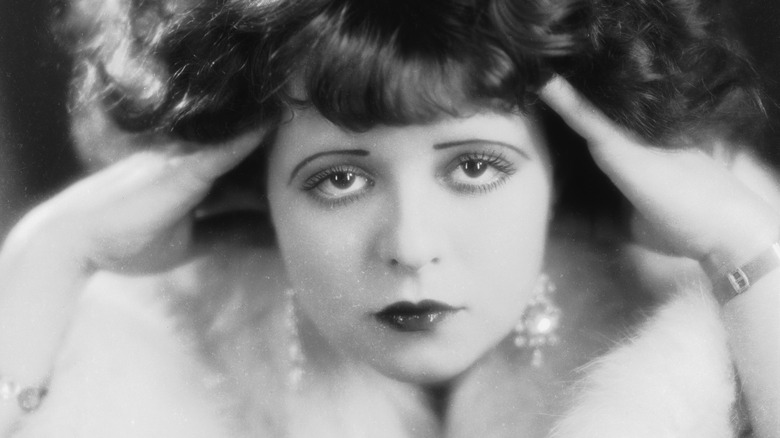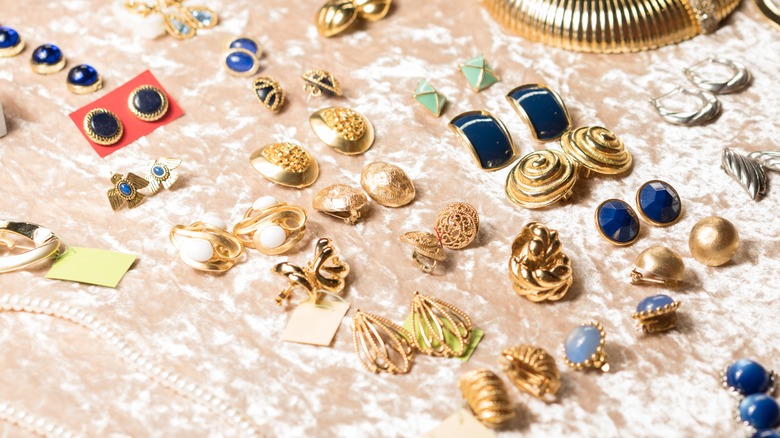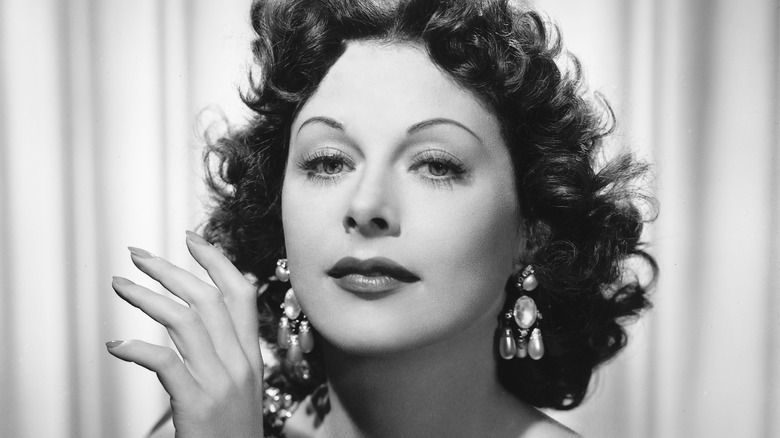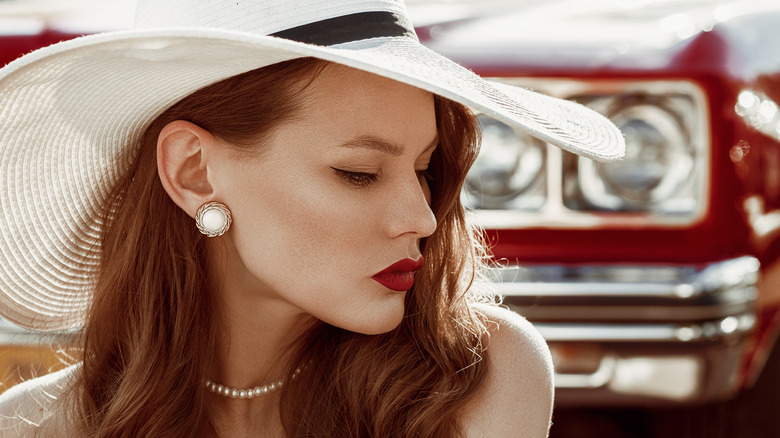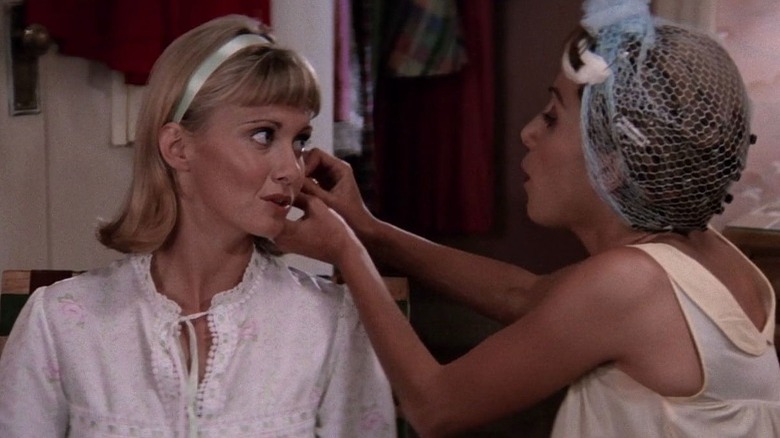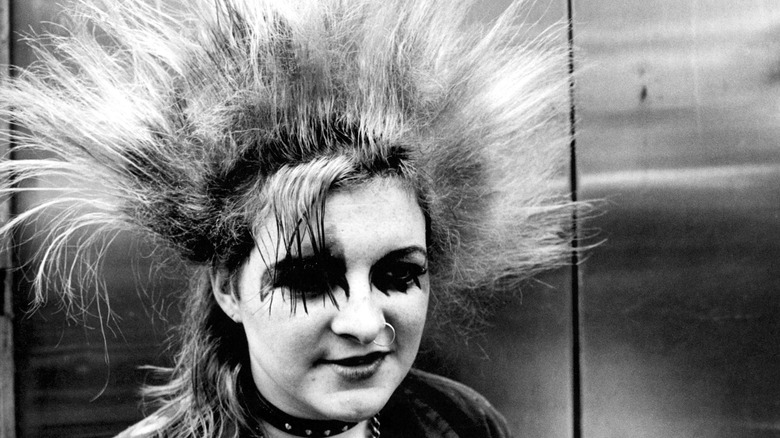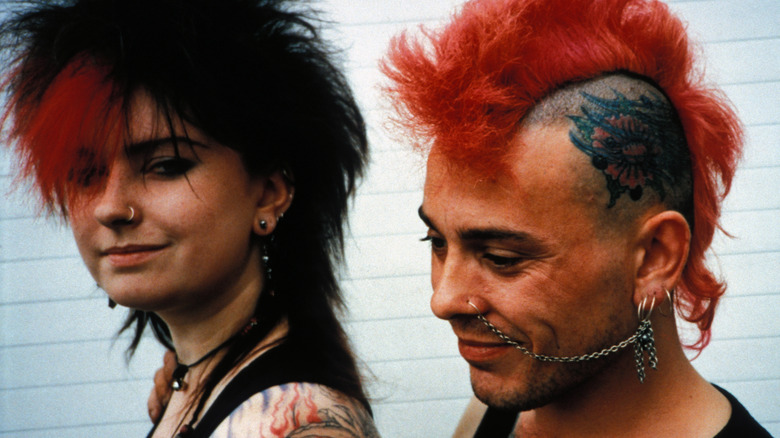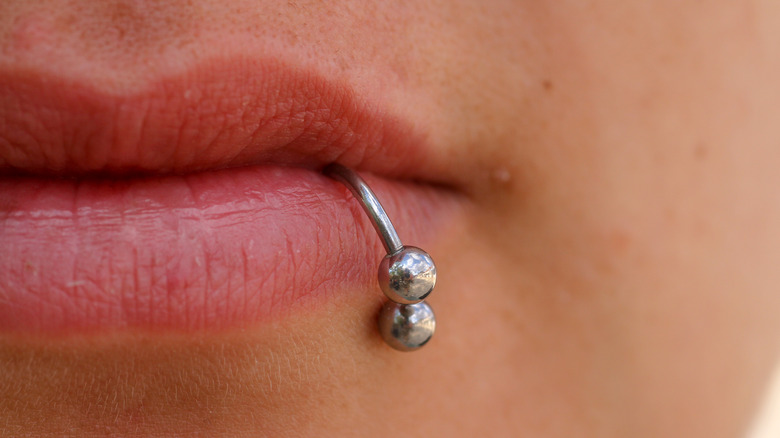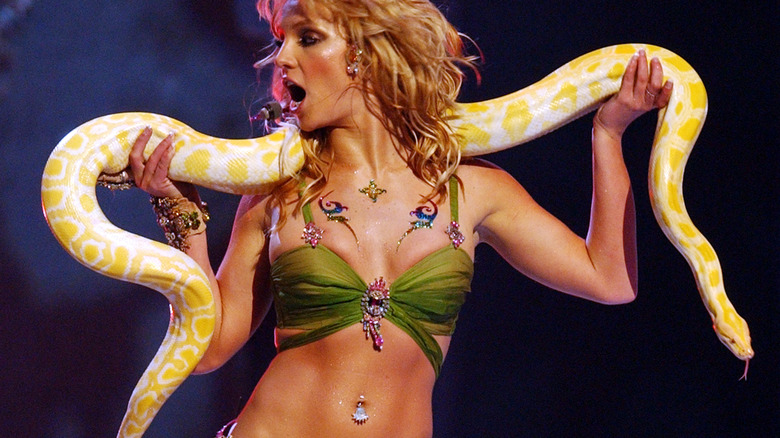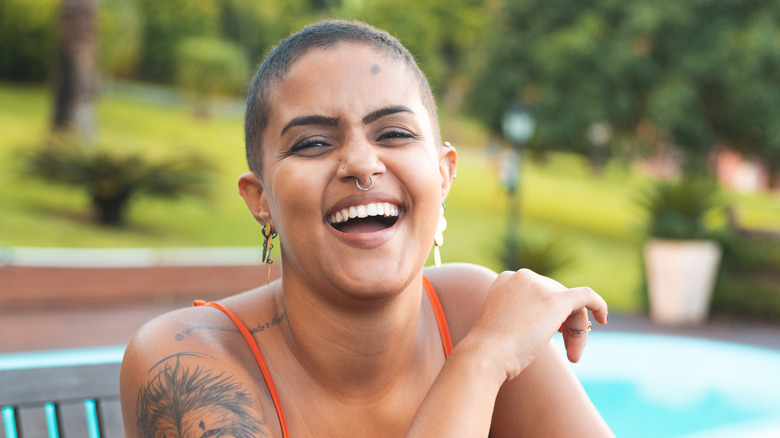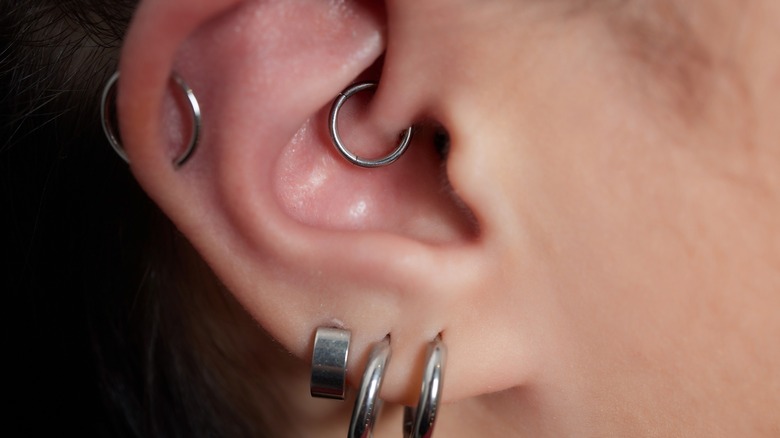100 Years Of Piercings
Dating back over 5,000 years, decorating your ears, face, and body with rings, jewels, and studs is one of humanity's oldest forms of self-expression. Over time, the meaning of getting a piercing has changed a great deal. While lobe piercings and ear stretching were popular with the ancient Egyptians as a means to showcase their wealth, body piercings have been enjoyed by people all over the globe. With origins in Hinduism, getting a nose piercing in India was regarded as a spiritual tradition, while some indigenous Australian cultures used septum piercings to celebrate the transition to adulthood or important occasions.
A history that includes clip-ons, nose studs, hoops, and belly button charms, the timeline of piercings, even in the last 100 years, is more varied and interesting than you'd think. Looking at the piercings of an era is a good way of understanding the fashion trends and changing interests of the time, from clip-on gems to ornate navel jewels. Like any fashion, art, or media trend, what was once considered to be the height of ear-related rebellion is a lot different from the piercing culture of today. Here's a rundown of the recent history of piercings and what the last 100 years could tell us about piercings in the future.
1920-1929: The rise of the clip-ons
During the 1920s, drop-style earrings reigned supreme. Often found gracing the ears of Hollywood stars and socialite flappers of the time, such as Clara Bow and Greta Garbo, the most favored earring designs were statement-making and often bold — symbolic of the "Roaring '20s" progressive period of social liberation as society was rising from the ashes after the Great War.
Pearls and drop-style earrings in various metallic and boxy designs were particularly popular because the newly short hairstyles and cloche hats of the decade allowed these long, highly decorative earrings to be shown off. "Jewelry was not based on function," costume collector Tracey Tolkien writes about the period in his book, "A Collector's Guide to Costume Jewelry" (via The Vintage Dancer). "... Jewelry need not act as a three-dimensional bank statement, but instead could be worn purely for its decorative qualities."
And while earrings themselves were often seen as an effortless way to show off wealth, having your ears physically pierced was a big no-no. Those who did wear earrings would instead have worn a single clip-on — a trend that would last for decades. In contrast to the pierced ear, wearing an ostentatious clip-on signaled that you were in the know about the latest fashion trends without breaking the societal standards and norms of the time.
1930-1939: Art deco piercings
While the clip-on was still the favored style of earring and would be for several more decades, piercings of the 1930s became heavily influenced by the art deco trends of the time. In contrast to the flowing, ornate designs of the previous decade, art deco earrings favored sharp lines, darker colors, and more rigid geometrics. During a decade dominated by the Great Depression, jewelry became a form of escapism and a covert way to make a cheaper outfit look expensive.
Earrings of the '30s were usually available as single clip-ons, with the shorter, rounder earring design beating out the long drop style earrings in popularity. Perhaps the biggest change of the era, the colors of the earrings also began to shift during the 1930s. As well as simple silvers and gold, the colors found in art deco architecture, clothing, and artwork found their way into the jewelry industry. From dark blues to mustard yellows and the classic black and white, the earring of the time favored a block color design.
If you wanted an alternative to this, gemstone colors were also coming back into fashion. Alongside the chandelier style of earrings still popular during this period, earrings made from topaz, aquamarine, and many other precious gems were also a fun way to spice up an outfit.
1940-1949: The birth of novelty costume jewelry
The 1940s signaled the beginning of a widespread shift in the kind of earrings people liked to wear — and no, we aren't talking about actual piercings that go through the skin just yet, as they were still considered a bit taboo. If you wanted to buy a pair of earrings in the 1940s, chances are that all your options would be clip-ons. Still, the more socially acceptable option, piercings your ears, was not just a fashion faux pas but was considered to be an unnatural sign of immortality.
However, jewelry of this period still continued to appreciate the beauty of piercings, with clip-on earrings being available in colorful and whimsical shapes. This jump from function to fun signaled an end to the art deco fad, as well as the fashion world's desire to look optimistically towards a brighter future. Popular earring designs of the time included flowers, frogs, bows, and cherries.
Due to post-war scarcities, materials like platinum and gold were rationed, so copper and other cheaper metals were included in earrings as a means to make them less expensive, giving rise to the style of jewelry known as "costume." The precious stones that influenced the '20s and '30s jewelry trends were also few and far between, with synthetic gems and semi-precious stones becoming popular amongst jewelers.
1950-1959: Plastic and pearls
In an era of affordability and clean, stylish designs, the culture surrounding piercings began to shift greatly during the 1950s. While gemstones and more expensive materials regained some of their popularity, the average American woman favored clean, bright, glamorous designs. With clip-ons still being the preferred style of earrings, small round designs which featured shapes such as fruit and flowers were also a trendy choice at the time.
Earrings began to be considered more as an active participant in a woman's outfit than a simple accessory — not only did your earrings match your outfit, but they were intended to compliment your complexion, as well as any other pieces of jewelry that accompanied the earrings, like a necklace, bracelet, or brooch. During a decade that focused on going back to basics, pearls again had a boom in popularity.
These were usually worn as single, ball-style clip-on earrings to give a sense of elegance and femininity. Recognizing their newfound popularity, bold, statement pearl jewelry began to be marketed in a variety of colors. Alongside the traditional black and white designs, yellow, brown, and beige-style pearls enjoyed a period of unconventional demand. At the same time, interest in non-conventional piercings was growing.
1960-1969: Becoming mainstream
A decade influenced by the elegance of the '50s and the color of the Pop Art movement, the 1960s was a fun time all around for piercings. With actual ear piercings gaining mainstream popularity, most people would pierce their ears at home, with young women having get-togethers to perform such painful activities with the trusty ice cube and sewing needle method. Professional piercers were few and far between, but some doctors performed the piercings if one wished to get one in a more sterile setting.
The actual design of the earrings worn during this period was similar to that of the '50s. There was a preference for flowers, longer styles, and bright colors. Tapping into the youth subculture and desire for boldness, resin and plastic single earrings gained popularity in blocky and eye-catching geometric designs. Popularized by famous models and Hollywood actresses like Twiggy and Elizabeth Taylor, chunkiness and mod-style bold lines were in.
A huge influence on jewelry and art culture alike, Indian and Southeast Asian-inspired earrings, designs, and colors were hitting their height of popularity with the hippie crowd. Featuring ornate designs, gold metallics, and deep-toned colors, this style finally spread to nose piercings, with the septum ring appearing in the U.S. for the first time.
1970-1979: Punk piercings
The piercings of the 1970s were all about rebellion. No longer just a way to show off your wealth or accentuate a new hairstyle, piercings took on a life of their own. They became a way to break taboos within the anti-establishment subcultures of the period. Facial piercings such as the nose ring, stud, and even septum became popular within the punk music scene.
Recognizing the demand for the kind of piercings you couldn't do at home, the number of professional piercings studios rose greatly by the end of the decade. Alongside this, jewelry trends also shifted significantly, with piercing chains that connected the nose and the ear lobes rising in prominence. Not content with just one set of earrings, piercing your cartilage and the idea of multiple single ear piercing also gained popularity during this time. The '70s shift in piercing culture wasn't just about location, however.
The eternal classic hoop earrings, in large and small styles alike, were especially popular. A style common within Latino, Native American, Egyptian, and East Asia cultures for many centuries beforehand, famous actresses and musicians such as Cher and Diana Ross became well known for their love of the hoop. This led to a widespread upswing in this iconic earring's popularity. While a style often associated with disco and the glam fun of the '70s and '80s, hoop earrings proved to be a trend that was here to stay for many decades to come.
1980-1989: Embracing the bold
Like the '70s, piercings of the 1980s were all about boldness and breaking the established social norms of the previous decades. While women in Hollywood and worldwide had been wearing earrings in various styles for decades, the '80s was the era in which piercings for men came back in a big way. With celebrity and pop culture icons such as Prince and Lenny Kravitz sporting small hoop earrings and studs, the single ear piercing's popularity with men began to rise alongside the more rebellious nose and facial piercings.
Alongside this, the 1980s saw the continued popularity of chunky and bold-colored jewelry. Plastic-style earrings were sold in block colors such as blue, red, and purple. Bold and unique designs were especially favored in this period, with celebrities and the average woman alike donning unique geometric creations. While the single lobe piercing was still the most common piercing for women in the U.S., multiple piercings were becoming increasingly common. Having second or third-lobe piercings and even cartilage piercings such as the helix became a fun way to bedazzle your ear and match the tone of an eye-catching outfit.
Piercing habits in rock and anti-establishment subcultures were also developing alongside this and becoming more creative with piercing habits. The septum piercing continued to have a burst in popularity, while newer modifications, such as the "Monroe" lip piercing coined after the iconic Hollywood actress, enjoyed some new attention.
1990-1999: Faking it
With the arrival of the 1990s, piercings finally completed their shift into mainstream approval via their popularity within celebrity culture. Not content with a simple lobe or nose ring, female celebs of the decade, such as Victoria Beckham (AKA Posh Spice), were pictured sporting faux lip rings and tongue studs in all shapes and sizes.
The '90s also marked the return of the '30s and '40s in a big way. Many of the piercings rocked by these stars were actually the result of fake jewelry. Clip-ons, especially facial ones, experienced a rise in popularity during the decade. If you were nervous about committing to an actual nose or lip piercing or afraid of what getting that piercing would entail, fake rings and studs were an easy way to keep up with popular trends and express yourself in a more temporary form.
Piercings as a form of alternative expression were still alive and well, however. Like the punk and rock fans before them, the grunge subculture of the '90s popularised having multiple ear piercings. More uncommon facial piercings like the eyebrow ring were used for the purpose of self-expression and to signal their non-conformity to the masses. And the beloved belly button piercing seen on nearly every Hollywood starlet for decades to come? The '90s propelled that trend in Western culture (thanks to model Christy Turlington who sported such a piercing on the runway in 1993).
2000-2010: Popstar piercings
If the 1990s were the decade of fake jewelry, Y2K was the era of bringing back the real. Alongside the continued popularity of nose studs and rings amongst young women, belly button bars, gems, and long ornate charms became one (if not the) most iconic fashion statements of the decade.
Sported by influential celebrities of the decade, including Britney Spears, Christina Aguilera, and Fergie, the wave of nose rings and belly button charms gracing the pages of many a gossip magazine only served to make the trend of unconventional piercings bigger and bolder. The navel piercing was particularly favored as they could be easily shown off alongside another of the decade's most iconic fashion items: low-rise jeans.
Eyebrow piercings and metallic nose studs in all shapes and colors also enjoyed some attention, while the more conventional lobe piercings were still in fashion amongst those wanting a more practical piercing. Like the transition from the '50s to the '60s, what kind of ear decoration the average woman was looking for in the 2000s had also shifted. Sequins, rhinestones, and daisies were favored over the previous dominance of pearls and art deco-style bold lines.
2010-2019: Modern piercings
A far cry from their previously taboo status, the 2010s only continued the trend of previously edgy piercings entering into mainstream culture. With multiple ear piercings, long-bar industrial piercings spanning the entire width of your ear, and a stacked lobe of up to four rings becoming fairly common amongst young people, gone were the days of clip-on earrings and fake rings
Celebrities, actresses, and musicians such as Zoë Kravitz, Scarlett Johansson, and Rihanna were all pictured during this time sporting up to a dozen different rings and studs in their ears at many red-carpet events. Professional piercing shops gained greater notoriety during the decade, with many people preferring to get their ambitious piercings done by a trained artist rather than attempting them at home.
After gaining popularity in the '70s, the hoop earring was here to stay and could be found in piercing shops across the nation in many different sizes and colors. The 2010s love for the casual hoop signals another shift in the history of piercings — the normalization of earrings (outside of simple studs) in professional settings. While facial piercings and body modifications such as stretched ears and dermal chest piercings were not necessarily welcome at the office yet, the 2010s marked a big shift in the status of piercings from an eccentric marker of nonconformity to casual accessorization.
2020-present: The piercings of today, tomorrow, and beyond
Today, most piercing trends and styles from the 2010s remain popular. But what does the world of piercings have in store for us this decade or even far into the future? While we're only a few years into the new decade, it seems as if our love for multiple piercings is on the rise. Like the 2010s, celebrities from Miley Cyrus to Dua Lipa have chosen to jump on the trend and rock their piercings on the red carpet.
While previous eras saw us stop at two or three earrings, the 2020s have proven that there are more ways to pierce an ear than you could have imagined. Custom earscaping, or curating the perfect stack of earrings, has become the go-to way of ensuring your piercings are as trendy as the rest of your outfit. "Right now, ear piercings are the most requested type," professional piercer Andrea Shaka explained to El País. "Doing designs tailored to each ear's [unique] anatomy is the most fashionable trend, for women especially, but for men as well."
Sporting names such as a "tragus" and a "rook," the piercing culture of the 2020s is as professional and intricate as it sounds. While the piercings of today may be extravagant, the public image of ear piercing is only getting more accepting. Like tattoos, multiple piercings are now worn by people from all walks of life. No longer an eccentric modification, piercings are now used as unconventional accessories and a subtle way to show off your unique personal style.
